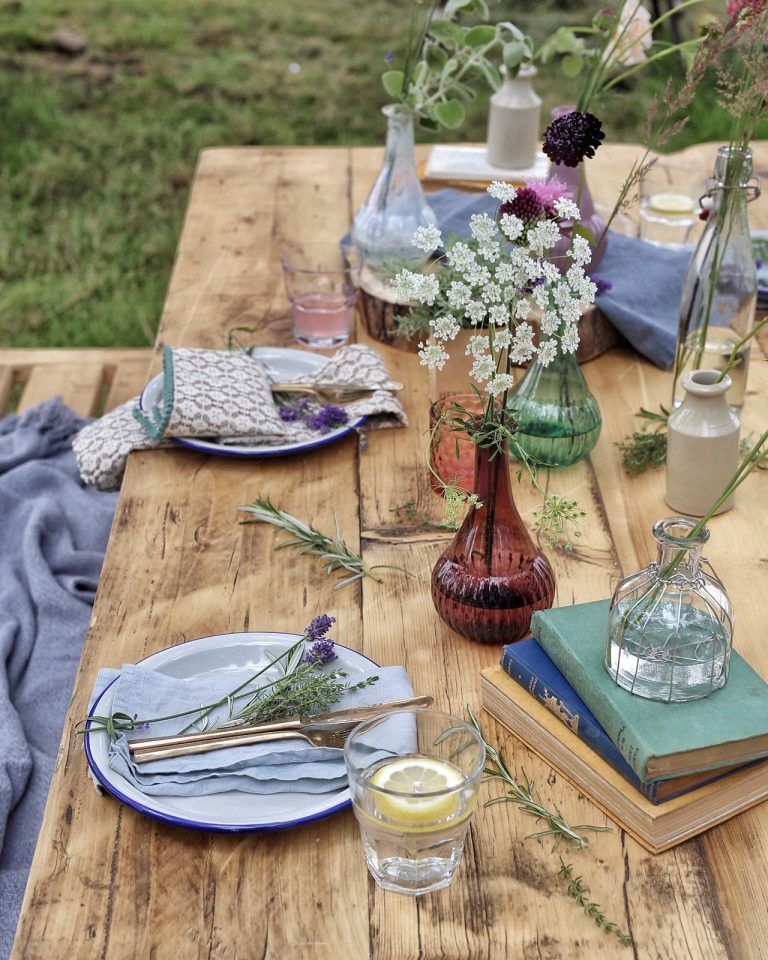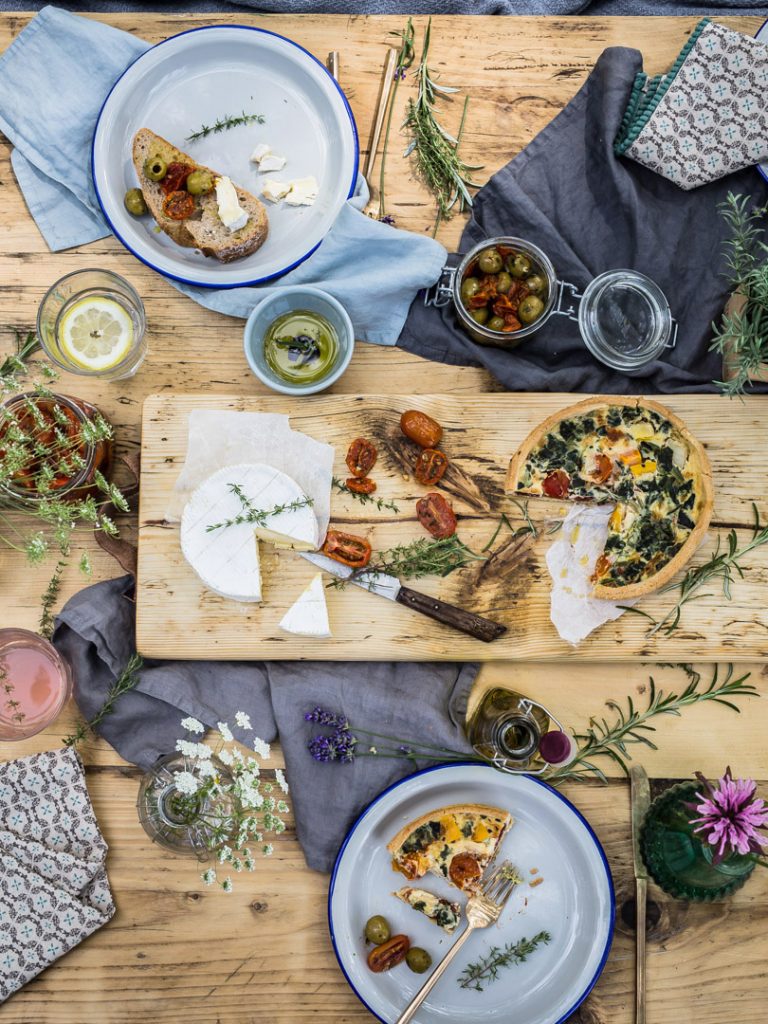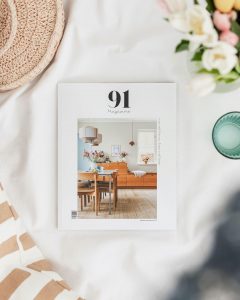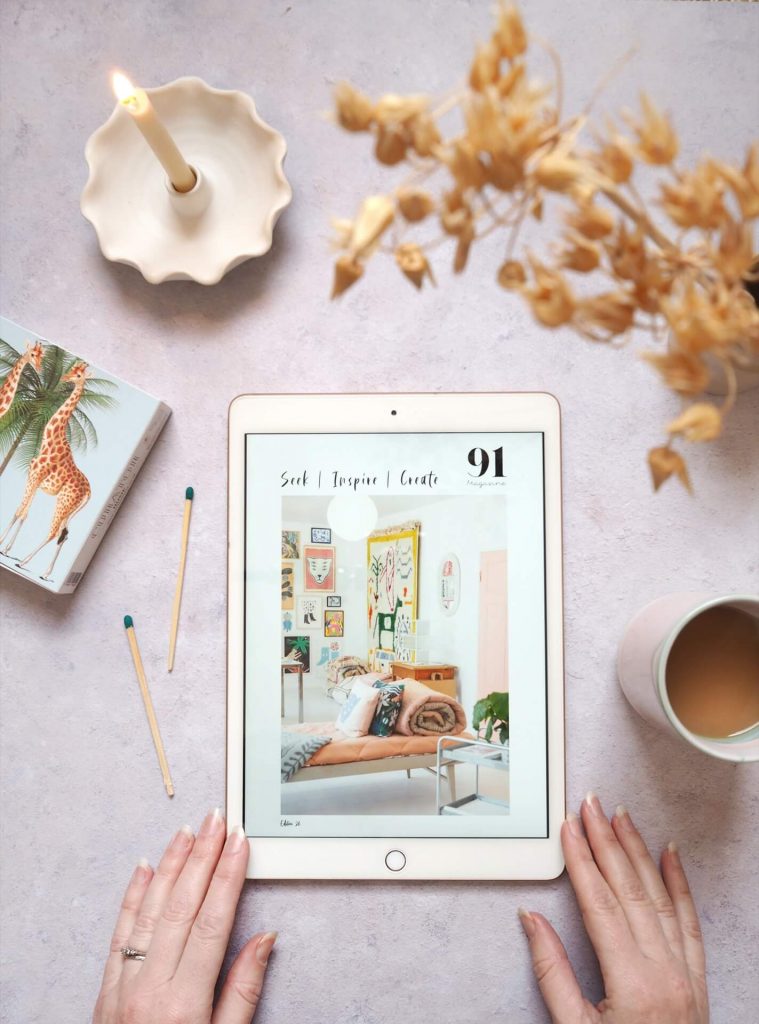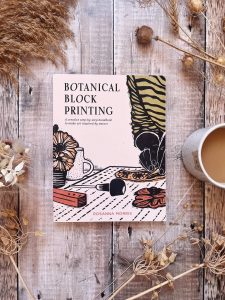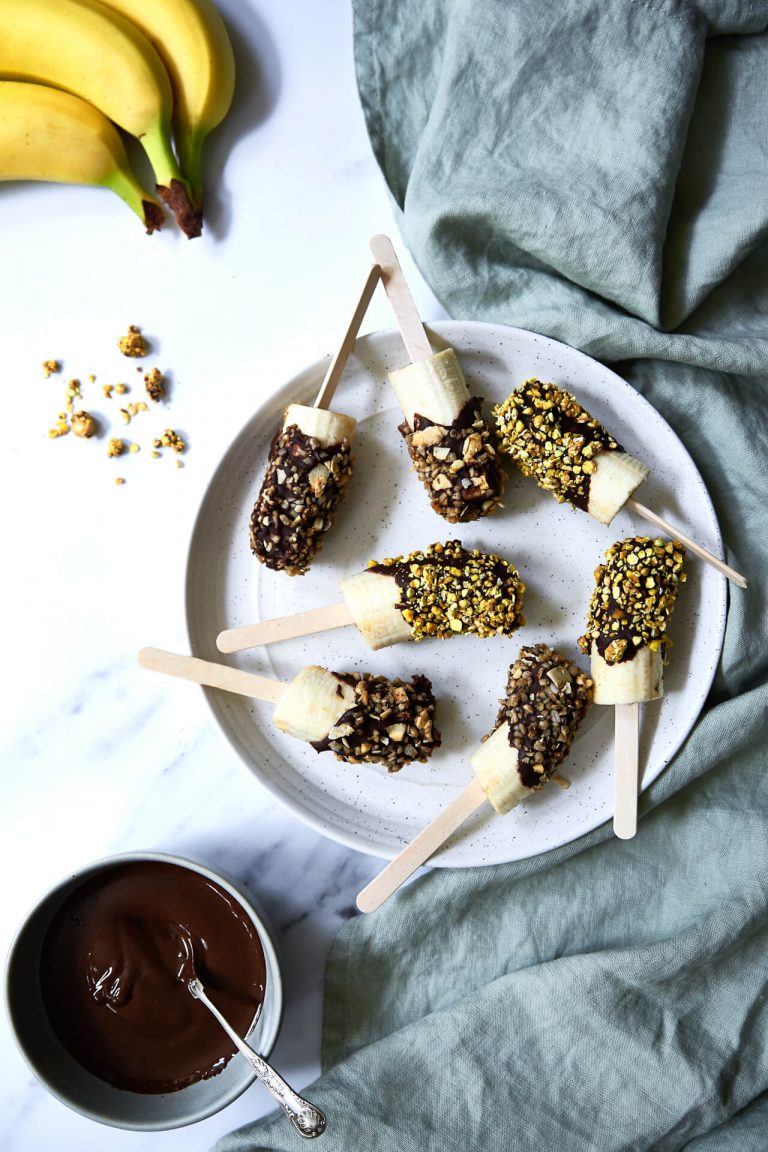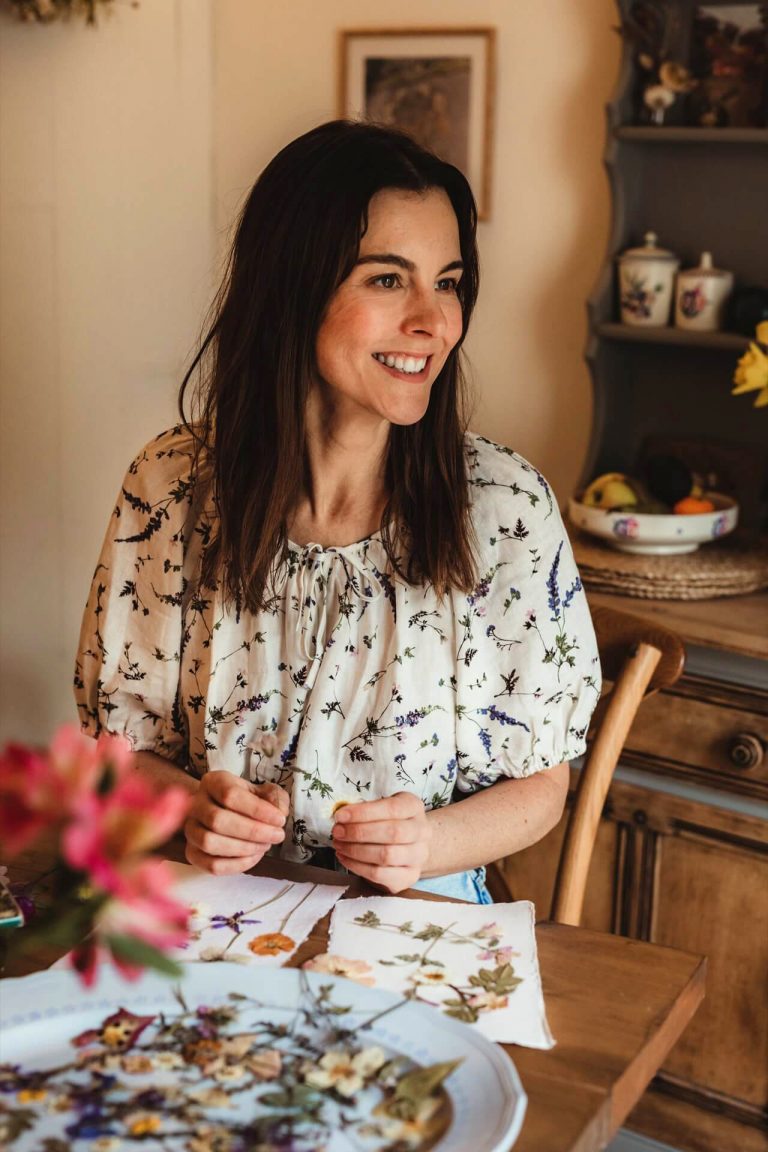Summer is in full flow, with the UK and Europe experiencing another extreme heatwave last week. The soaring temperatures come accompanied with a stark reminder of the global climate crisis we are facing. Change is needed and fast, and while we may not be able to halt the use of fossil fuels individually, we can at least make small changes within our own every day, aiming to be more eco-conscious and sustainable.
With summer parties and gatherings on the horizon, we asked three small business owners to collaborate and combine their passions for food and pretty things with their love of styling and sustainability and pull together an eco-conscious summer garden table without compromising style. Katia Wlodarczak, Claire Street and Nikkita Palmer have put together these hints and tips to make the most of what you already have when styling your outdoor space.
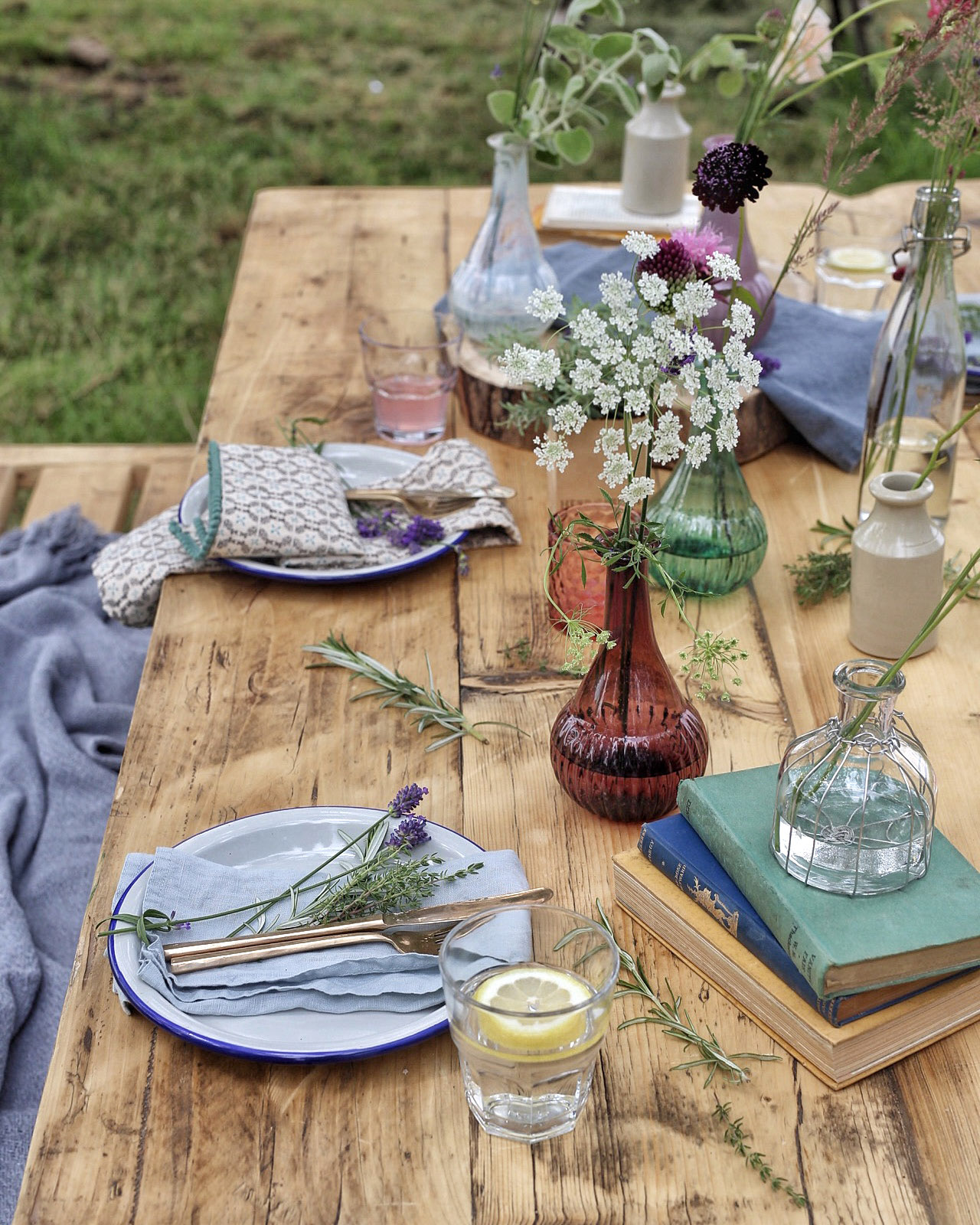
We fill our homes with furniture and accessories we love, so when summer comes around, why shouldn’t we make our outdoor spaces look just as Insta-worthy?! Reusing items that you love and have already invested in is key to making your space both personal, practical and ready to enjoy the summer. A few simple home accessories such as blankets, throws, cushions, trays and chairs can be combined to create the laid-back and homely atmosphere we have created here.
Consider how to reuse existing furniture pieces, whether it be moving your dining table to the garden, or using benches, trunks and crates as side tables for an eclectic feel on summer evenings. Avoid succumbing to cheap white plastic garden furniture as they lack quality and we so very often see them end up in landfill. Opt for floor cushions and vintage deckchairs for a more individual and planet-friendly look. For the creatives amongst you, make your own reclaimed folding table from previously discarded wood (or other materials) or simply make a stack of pallets for a low level chilled out vibe. These can be easily dressed with rugs, fabrics, linens and some simple vases of flowers moved from the inside to out.
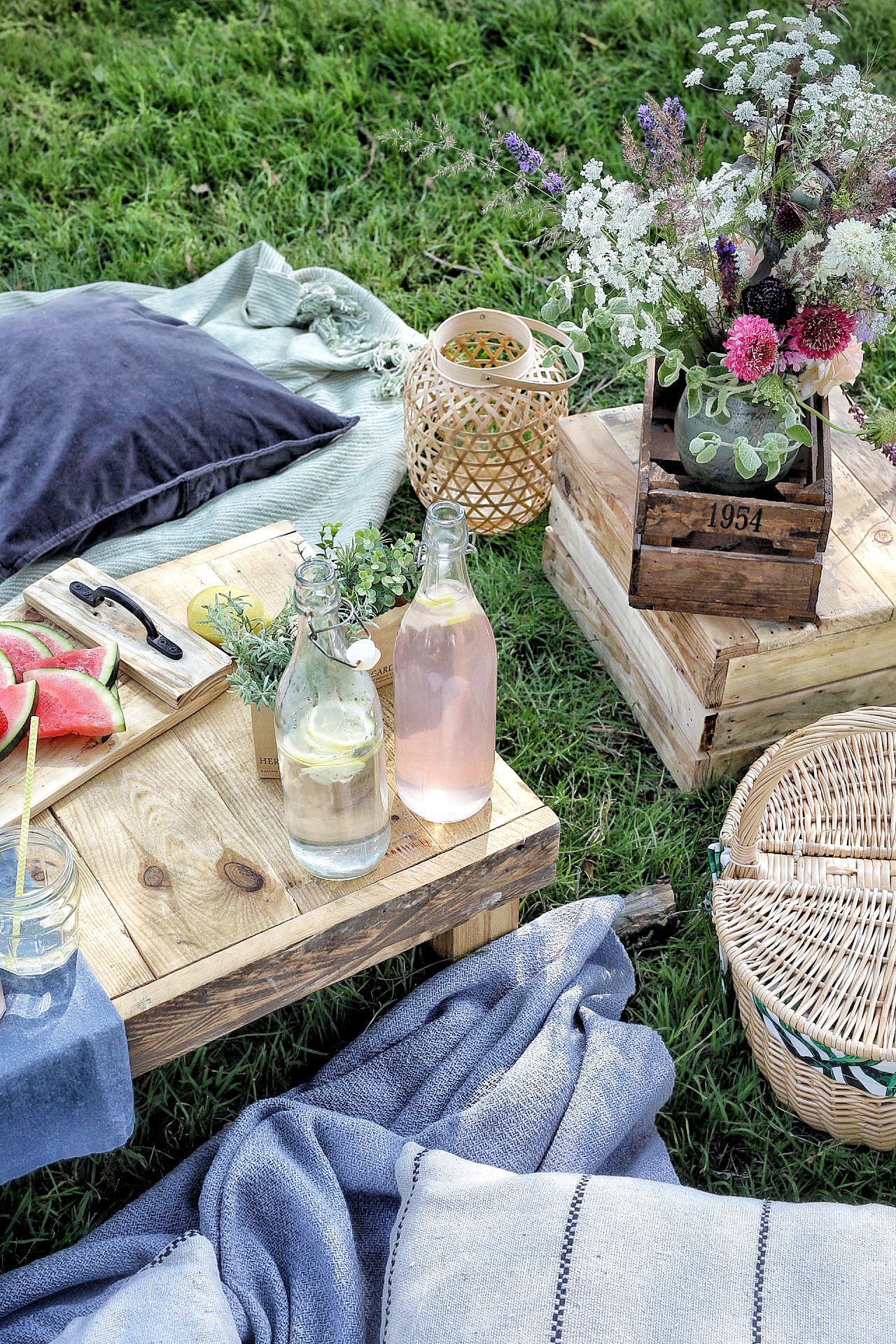
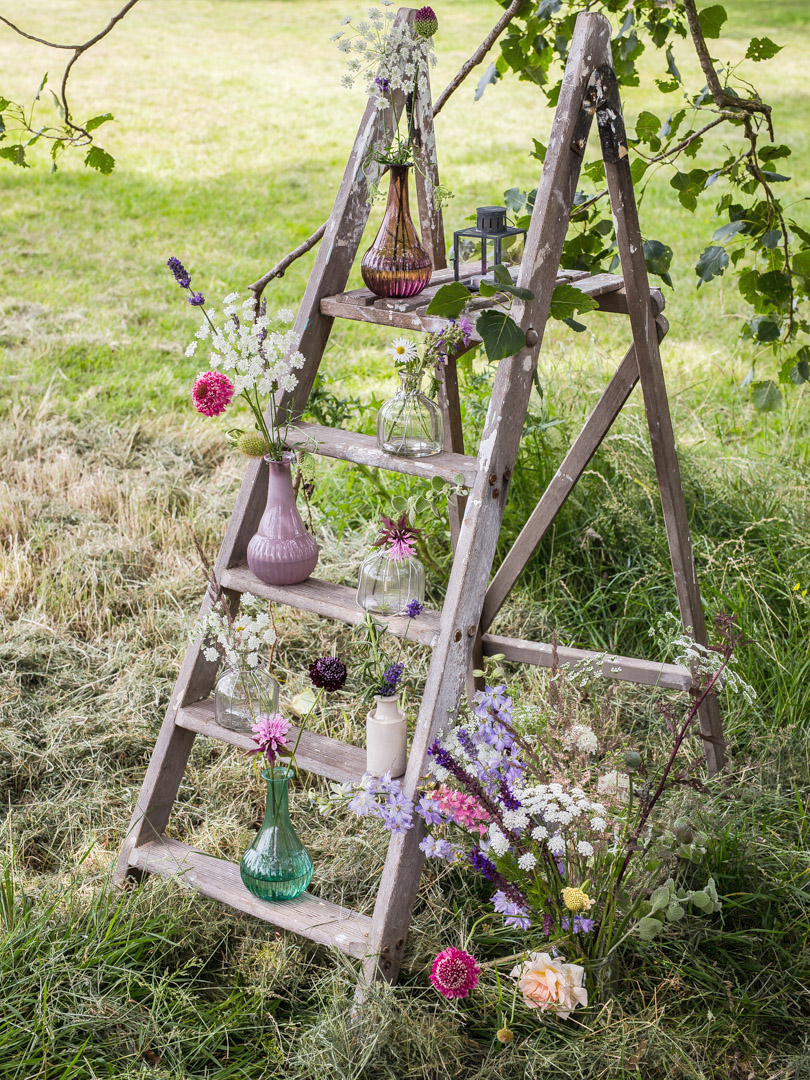
Avoid using shop bought flowers with excessive plastic packaging and transportation and opt for picking your own wild flowers from the garden, hedgerows, meadows or canals if possible. Alternatively, use a local grower for beautiful flowers which are often not easily found in the shops and support a small business in the process. Emma Connolly from A Bunch Of Wild provided us with an assortment of ammi, scabious, larkspur, lavender and rose chandos beauty.
Flowers can be arranged in vintage or new glass vases in a combination of colours and textures to get the pretty summer garden look seen here. Add a range of heights to your table to give variation with log slices (sourced from your local timber merchant) or stacks of vintage books. If using small quantities opt for odd numbers of arrangements for balance.
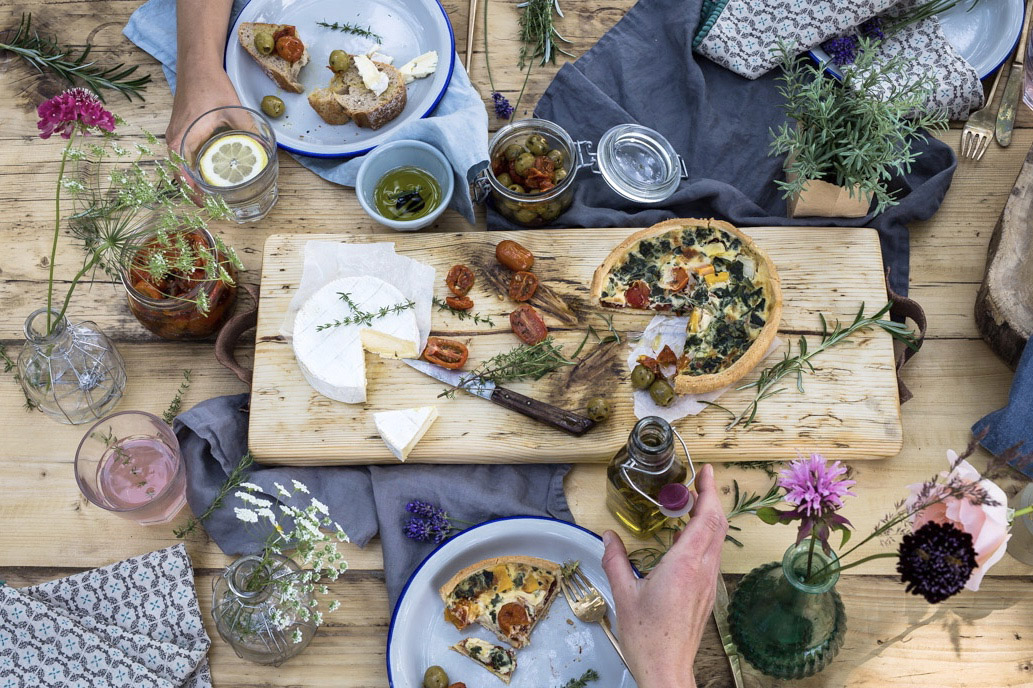
Forget paper plates and plastic cups and either bring out your own crockery or durable vintage enamelware. Great for camping holidays and garden use as they are both practical and beautiful – we love British based Falcon Enamelware. Replace paper napkins with linen or fabrics which can be used again and again. Work with what you have combining patterns and similar colours. An eclectic mix looks so much more relaxed than a formal matching table setting. An easy but effective tip is to fold your linens and add stems of lavender or eucalyptus with your cutlery – when entertaining, add a handwritten name tag on leaves or natural papers for more personalisation.
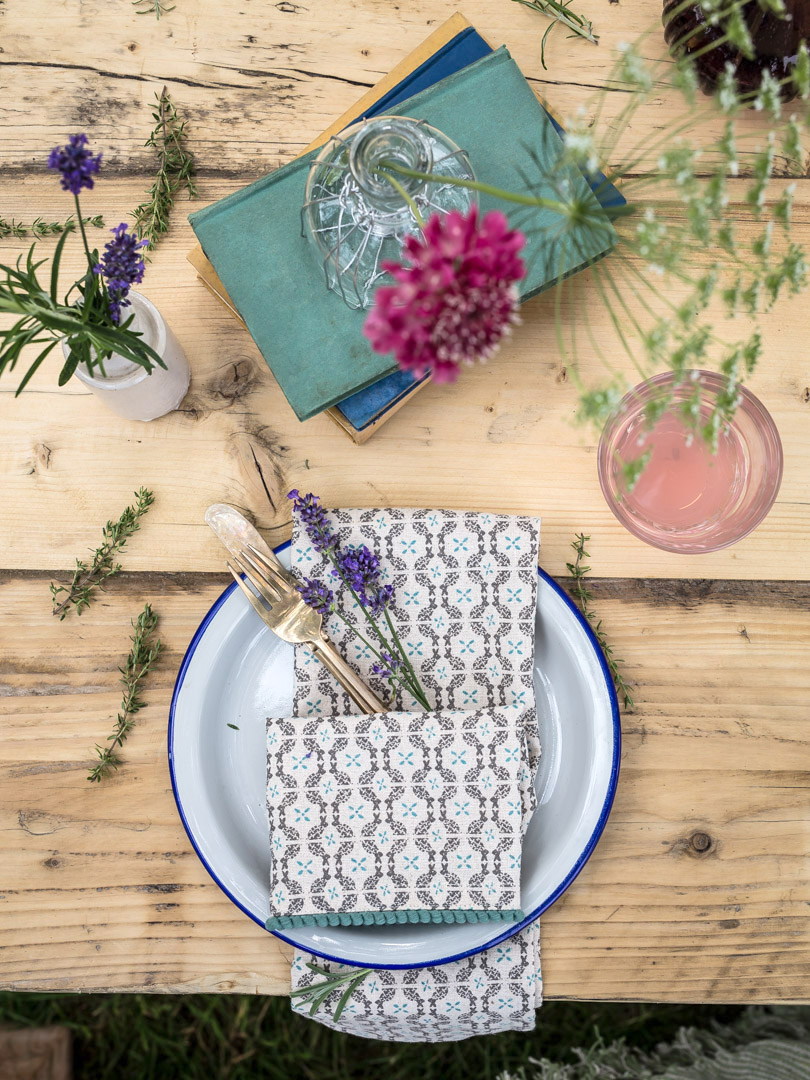
Plastic cutlery is most definitely a thing of the past. Reusable picnic sets are great if you’re going out of the house, or just use the cutlery you have at home. Replace single use bags with baskets and crates which are not only more space effective and organised but also look great. Serve your handmade treats on sharing wooden boards for a real feeling of gathering – ours are made from reclaimed timber which you could make yourself at home. (see hints and tips for this below)
Don’t forget to consider atmosphere when styling your outside space. If you are taking it into the evening consider lighting and the intensity of this, we love warm festoon lights draped from branches or trees (there are solar-powered ones available) as well as glass and wooden lanterns at a range of heights scattered around the space.
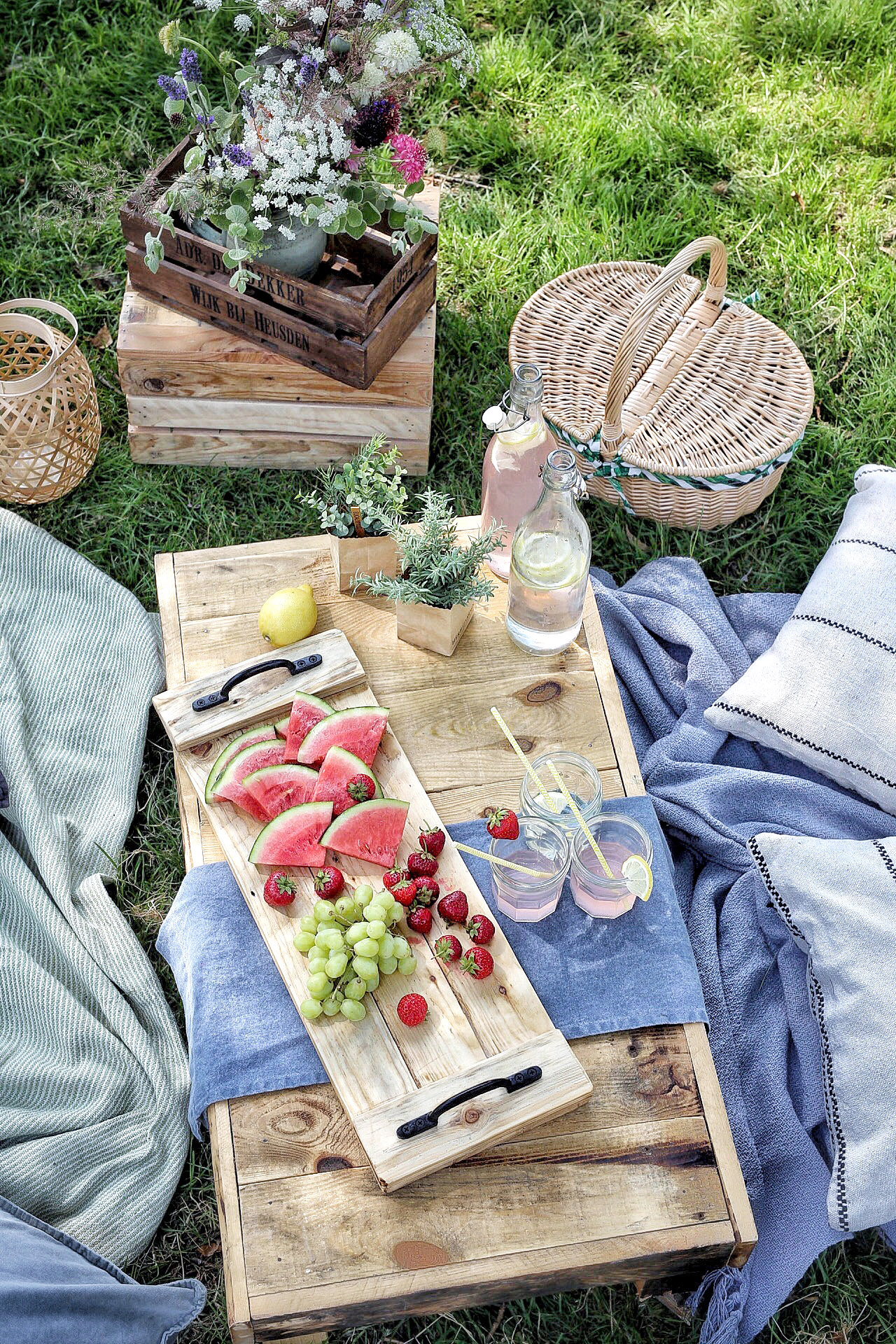
CREATE YOUR OWN RECLAIMED SERVING BOARD
We use a reclaimed pallet board for our serving trays as well as a chunkier timber when it is available. We highly recommend you work with what you have for the best and most personal feel. We source lots of our reclaimed timber from the building industry but you will readily find discarded pallets on Gumtree, Freecycle or Facebook marketplace for little to no money. However, always be sure to ask permission before taking anything.
When choosing your pallets, be sure they have a HT stamp on them, this means they have been heat treated to remove any nasty chemicals or bugs. Of course, you will need to sand your boards back for the best finish. We recommend using a low grit sand paper to start with (80 grit) and to finish with a higher grade such as a 120. Once finished, be sure to coat any wood used with a food safe finishing wood oil, we use a natural mineral oil or an alternative chopping board oil available from homeware stores or online.
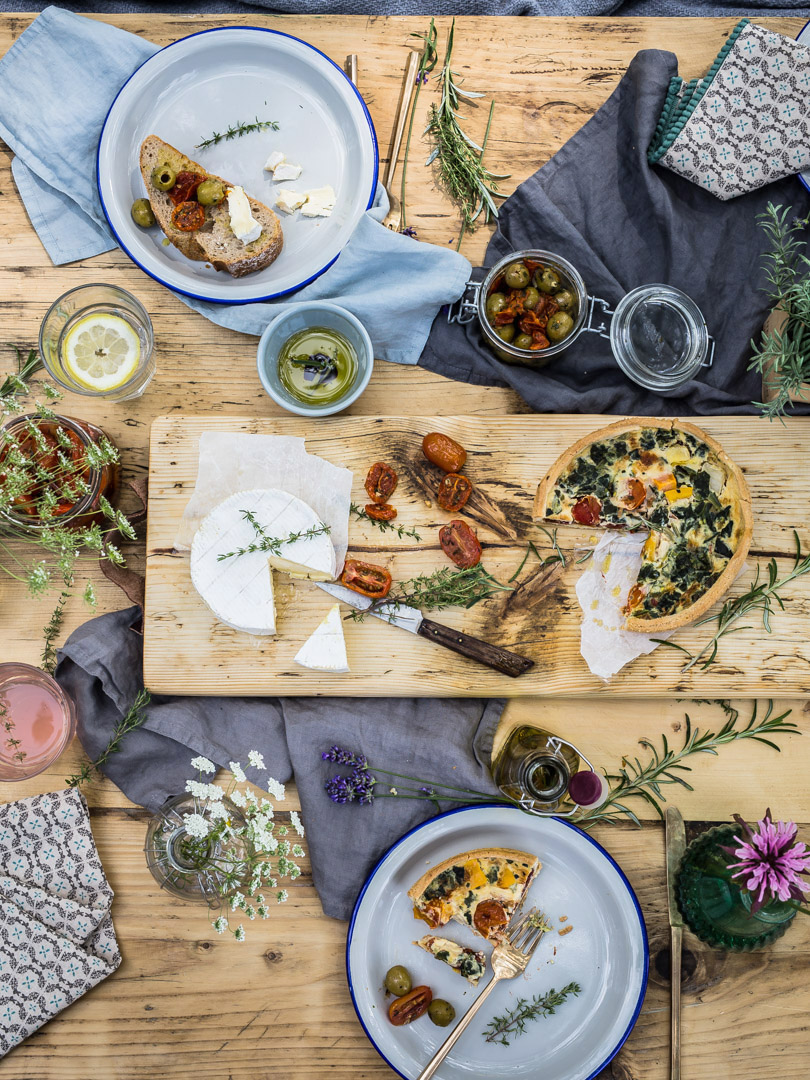
HOMEMADE QUICHE RECIPE
The quiche can be eaten straight away but to show it at its best, make it a day in advance and serve warm or at room temperature. Making your own pastry and adding parmesan and freshly ground black pepper to the flour will make the crust a bit more interesting. Plus, using just an egg and no water will make it more crumbly & delicate.
YOU WILL NEED:
For the pastry:
- 200g plain flour
- 30g parmesan
- 100g cold unsalted butter, cubed
- 1 medium egg, lightly beaten
- Black pepper, coarse, a few turns from the mill
METHOD:
- Rub the butter in the flour using your fingers or a mixer fitted with the paddle attachment until it resembles breadcrumbs.
- Add the lightly beaten egg and continue mixing until a small dough is just formed. Don’t overwork it!
- Shape the dough into a thick disk, wrap and rest in the fridge. After 30 minutes, roll out the disk out to a thickness of 2-3mm between 2 sheets of baking parchment. If you have time, let it rest in the fridge some more. The more rest, the less shrinkage.
- Line a 20cm tart tin with the pastry sheet, Prick the base and place it in the freezer for 10 minutes.
- Scrunch up one of the pieces of baking parchment, lay it in the chilled pastry case and cover with baking beans, or better – some coins from your penny jar.
- Blind bake in the oven for 30 minutes at 180°C. Remove the parchment with the beans or coins and return to the oven for a further 10 minutes. Reduce it to 120-140°C to bake the filling.
For the filling:
- 3 large eggs
- 300ml single or whipping cream
- 1 small red onion, peeled and finely sliced
- 1 small courgette dices
- 1 small yellow or red pepper
- A few cherry tomatoes, quartered
- Small hand-full of spinach (optional – to add a green touch)
- Salt and pepper
- Olive oil
- ½ tsp Herbes de Provence
METHOD:
1. Fry all your vegetables in a little olive oil, just like making a summer ratatouille, ideally one by one.
2. Mix the eggs with the cream in a saucepan. Add the vegetables, spinach if using and the herbes de Provence. Season with salt and pepper.
3. Gently heat until warm. If you have a thermometer, use it to bring the mix to 60°C (not more or it will start to set). By doing that, the filling will set faster in the oven, avoiding the undesirable “soggy bottom”.
4. Make sure the pastry case is still warm when filling. Return to the oven for approximately 20 to 30 minutes. Give the tin a slight wobble once in a while and remove from the oven as soon as the centre doesn’t feel liquid anymore.
5. Let it cool at room temperature for 20 minutes if eating straight away or before putting it back in the fridge to rest overnight. The following day, bring back to room temperature or warm in a preheated over at 160°C for 5-10mins.
Photography: Katia Wlodarczak – @gourmandpixels
Styling: Claire Street – @neathomeware
Words: Nikkita Palmer – @nikkitapdesigns
